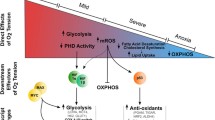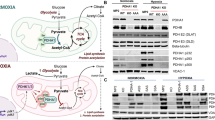Abstract
Ischemic stress of cells within solid tumors arises from inadequate perfusion of regions of the tumor and results in microenvironments which are hypoxic and deficient in nutrient delivery and waste product removal. Stressed cells within these microenvironments show growth inhibition and synthesize unique sets of proteins referred to as glucose and oxygen regulated proteins (GRPs and ORPs respectively). The commonality of proteins induced by glucose-starvation and hypoxia has not been proven. To this end, ORPs were induced in Chinese hamster ovary cells in the presence of high glucose concentration in the media and ORP 80 isolated from two dimension gels. Eleven tryptic peptides of the 80 kDa ORP were sequenced and found to be identical to GRP 78 sequences. The data demonstrate that GRP 78 and ORP 80 have the same primary amino acid sequence and suggest that glucose-starvation and hypoxia can induce the same cellular responses.
Similar content being viewed by others
References
Sutherland RM: Cell and environment interactions in tumor microregions: The multicell spheroid model. Science 240: 177–184, 1988
Colemann NC: Hypoxia in tumors: A paradigm for the approach to biochemical and physiologic heterogeneity. J Natl Can Inst 80: 310–317, 1988
Vaupel P, Kallinowski F: Tissue oxygenation of primary and xenotransplanted human tumours. Radiat Res 2: 707–712, 1987
Sutherland RM, Keng PC, Conroy PJ, McDermott D, Bareham BJ, Passalacqua W: In vitro hypoxic cytotoxicity of nitroimidazoles: Uptake and cell cycle phase specificity. Int J Radiat Oncol Biol Phys 8: 745–748, 1982
Wilson RE, Keng PC, Sutherland RM: Drug resistance in Chinese hamster ovary cells during recovery from severe hypoxia. J Natl Can Inst 81: 1235–1240, 1989
Michael BD, Adams GE, Hewitt HB, Jones WBG, Watts ME: A posteffect of oxygen in irradiated bacteria: A submillisecond fast mixing study. Radiation Res. 54: 239–251, 1973
Koch CJ: Oxygen effects in radiobiology. Adv Exp Med Biol 157: 123–144, 1982
De Groot H, Noll T: Oxygen gradients: The problem of hypoxia. Biochem Soc Transact (London) 15: 363–365, 1987
Kock CJ, Kruuv J: The effect of extreme hypoxia on recovery after radiation by synchronized mammalian cells. Rad. Res. 48: 74–85, 1971
Kwok TT, Sutherland RM: The relationship between radiation response of human squamous carcinoma cells and specific metabolic changes induced by chronic hypoxia. Int J Radiat Oncol Biol Phys 16: 1301–1305, 1989
Kwok TT, Sutherland RM: The radiation response of cells recovering after chronic hypoxia. Rad Res 119: 261–270, 1989
Shen J, Hughes C, Chao C, Cai J, Bartels C, Gessner T, Subject J: Coinduction of glucose-regulated proteins and doxorubicin resistance in Chinese hamster cells. Proc Natl Acad Sci USA 84: 3278–3282, 1987
Webster KA, Murphy BJ: Regulation of tissue specific glycolytic isozyme genes: Coordinate response to O2 availability in myogenic cells. Can J Zool 66: 1046–1051, 988
Heacock CS, Sutherland RM: Enhanced synthesis of stress proteins caused by hypoxia and relation to altered cell growth and metabolism. Br J Cancer in press, 1990
Heacock CS, Sutherland RM: Induction characteristics of oxygen regulated proteins. Int J Radiat Oncol Biol Phys 12: 1287–1290, 1986
Sciandra JJ, Subjeck JR, Hughes CS: Induction of glucose-regulated proteins during anaerobic exposure and of heatshock proteins after reoxygenation. Proc Natl Acad Sci USA 81: 4843–4847, 1984
Pelman HRB: Speculations on the functions of the major heat shock and glucose-regulated proteins. Cell 46: 959–961, 1986
Kozutsumi Y, Segel M, Normington K, Gething MJ, Sambrook J: The presence of malfoided proteins in the endoplasmic reticulum signals the induction of glucose-regulated proteins. Nature 332: 462–464, 1988
Lee AS, Delegeane AM, Baker V, Chow PC: Transcriptional regulation of two genes specifically induced by glucose starvation in a hamster mutant fibroblast cell line. J Biol Chem 258: 597–603, 1983
Rice GC, Spiro IJ, Clifton CL: Detection of S-phase overreplication following chronic hypoxia using a monoclonal anti-BrdUrd. Int J Radiat Oncol Biol Phys 11: 1817–1822, 1985
Young SD, Marshall RS, Hill RP: Hypoxia induces DNA overreplication and enhances metastatic potential of murine tumor cells. Proc Natl Acad Sci (USA) 85: 9533–9537, 1988
Shen JW, Subject JR, Lock RB, Ross WE: Depletion of topoisomerase II in isolated nuclei during a glucose regulated stress response. Mol Cell Biol 9: 3284–3291, 1989
O'Farrell PH: High resolution two-dimensional electrophoresis of proteins. J Biol Chem 250: 4007–4021, 1975
Ting J, Wooden SK, Kriz R, Kelleher K, Kaufman RJ, Lee AS: The nucleotide sequence encoding the hamster 78-kDa glucose-regulated protein (GRP78) and its conservation between hamster and rat. Gene 55: 147–152, 1987
Munro S, Pelman HRB: An Hsp70-like protein in the ER: Identity with the 78 kd glucose-regulated protein and immunoglobulin heavy chain binding protein. Cell 46: 291–300, 1986
Craig EA, Kramer J, Shilling J, Werner-Washburne M, Holmes S, Kosic-Smithers J, Nicolet CM: SSC1, an essential member of the yeast HSP70 multigene family encodes a mitochondrial protein. Mol Cell Biol 9: 3000–3008, 1989
Normington K, Kohno K, Kozutsumi Y, Gething MJ, Sambrook J: S. cerevisiae encodes an essential protein homologous in sequence and function to mammalian BiP. Cell 57: 1223–1236, 1989
Rose MD, Misra LM, Vogel JP: KAR2, a karyogamy gene, is the yeast homolog to the mammalian BiP/GRP78 gene. Cell 57: 1211–1221, 1989
Vogel JP, Misra LM, Rose MD: Loss of BiP/GRP78 function blocks translocation of secretory proteins in yeast. J Cell Biol 110: 1885–1895, 1990
Author information
Authors and Affiliations
Rights and permissions
About this article
Cite this article
Roll, D.E., Murphy, B.J., Laderoute, K.R. et al. Oxygen regulated 80 kDa protein and glucose regulated 78 kDa protein are identical. Mol Cell Biochem 103, 141–148 (1991). https://doi.org/10.1007/BF00227480
Received:
Accepted:
Issue Date:
DOI: https://doi.org/10.1007/BF00227480




